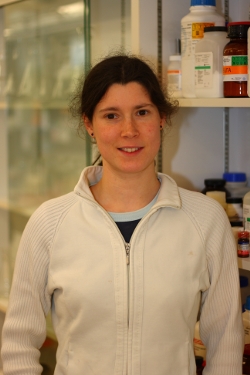

Laetitia Martin
Graduate Student
My research focuses on understanding the mechanisms of fruit cuticle biosynthesis, using tomato (Solanum lycopersicum) as a model system. While the major biochemical components of the tomato fruit cuticle are mostly known, along with many steps in the underlying biosynthesis pathways, key aspects of cuticle biology remain unclear. A major poorly understood area is the regulation of cuticle formation. To address this, I am studying the role of an HD-Zip IV transcription factor (CD2) and the hormone abscisic acid in cuticle development. Another aspect of cuticle formation that has been a longstanding mystery is the polymerization of cutin, the predominant component of most cuticles. We recently identified the enzyme responsible for extracellular cutin polymerization of cutin, cutin synthase, recently renamed CUTIN SYNTHASE-LIKE 1 (CUS1), taking advantage of a tomato fruit cutin deficient mutant cutin deficient 1 (cd1).
*these authors contributed equally to this work.